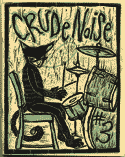Woodcut and Linocut in Zine Production
Woodcut and Linocut are two printmaking techniques that have been used in zines.
Woodcut
In a Woodcut an image is carved into the surface of a block of wood, with the printing parts remaining level with the surface while the non-printing parts are removed, typically with a special chisel that has a rounded or troughlike blade that is called a gouge. The areas to show 'white' are cut away with a knife or chisel, leaving the characters or image to show in 'black' at the original surface level. The block is cut along the grain of the wood.
Multiple colors can be printed by keying the paper to a frame around the woodblocks (where a different block is used for each color). The woodcut can be printed on to the zine by several different ways. Firstly a roller is used to apply print ink to the woodcut. The woodcut can then be stamped on to the paper. It can also be printed onto the zine by placing the woodcut face up on a table or other surface and placing the page to be printed onto the woodcut and then rubbing on the back of the page with a spoon to ensure an even application of the page to the print ink on the wood cut. Another possibility is a printing press. Different woods can be used and the choice of wood depends on the zinester’s preference.
Linocut

Linocut is a variant of woodcut in which a design is cut into a sheet of linoleum with a sharp knife or lino cutter. A design/drawing is carved into the lino via the knife cutting out shearings of lino from the sheet. The linoleum sheet is then inked with a roller and then pressed on to paper. The printing can be done by hand or a press. Linoleum is much easier to cut into than wood but the pressure of the printing process is said to degrade the linoleum faster than wood. However linoleum prints still last a long time and can produce hundreds of prints.
Colour linocuts can be made by using a different block for each colour, as in woodcut, or by using a single piece of linoleum in which after each successive colour is imprinted onto the paper, the artist then cleans the lino and cuts away what will not be imprinted for the subsequently applied colour.
Due to ease of producing a linocut, the cost of materials and ability to print without needing a printing press, linocut has been used in zine production. The easiest way in which lino can be used in zine production is when a zine contains an illustration that is made in a lino print and this is then photocopied for mass production of the zine. The alternative is to make a lino print on each copy of the zine. This means that the zine writer has to ink up their lino cut and print it onto each copy of his or her zine. While this produces an additional work load, it is a technique that is accessible for zine writers and has been used. It produces an additional aspect of the zine – colours in a black and white photocopied zine, the texture of the paint on the paper adds a different feel to the zine as well as making the printed page heavier – which can be an advantage for the cover of the zine.
It is unknown what zines were the first to start using woodcuts or linocuts but it is possibly that such zines did such productions on a small scale and consequently there would be little documentation of their existence. Different levels of technical skill exist with respect to both woodcut and linocuts which can be seen in prints with several colours – and ‘reductive’ lino prints. Other print processes that have been used in zine production include Screenprinting.
Zines that contain wood and/or linocuts
- Beyond: Editor Rosco E. Wright made his own lino cuts for his fanzine.
- Crude Noise #2: Two colour linoleum block print by Meredith Stern, 500 copies.
- Crude Noise #3: Two color linoleum block print letterpresses by Meredith Stern, 700 copies.
- Crude Noise #4: Two colour linoleum block print by Meredith Stern, 500 hand printed copies; 100 photocopied covers.
- The Dragomen: Two colour silkscreened cover, hand cut and pasted extra details, 486 copies.
- The Heart Star: One colour linoleum print cover, 324 copies.
- Loserdom #14: Back cover had single colour linoleum print, 300 copies.
- Loserdom #16: Front and Back and inside covers had 6 single colour linoleum prints, 400 copies.
- The Nekromantikon: Two colour linoleum print by Manly Banister on cover.
- Nosedive #12: Two colour linoleum print on cover.
- Slant: Multi colour linoleum print by James White on cover.
- Thoughtworm
- Viewpoints: Linoleum print by Rosco E. Wright on cover
- The way of D.I.Y. Rocking: And they are saying: Back cover had single colour linoleum print, 200 copies.
- The way of D.I.Y. Rocking: Open shirts and raised collars: Back cover and two inside pages had single colour linoleum prints, 250 copies.

